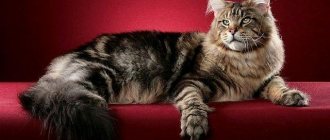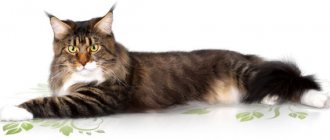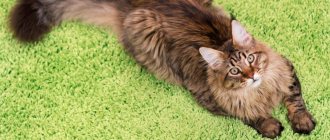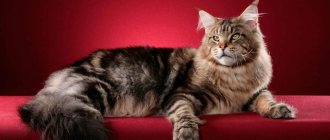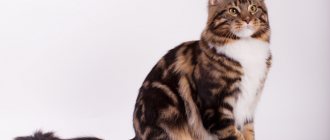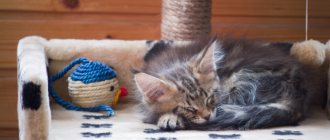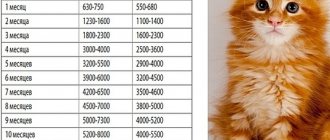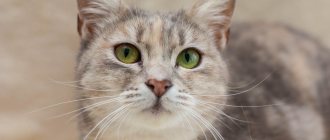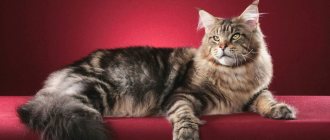Maine Coons are a breed that is very popular nowadays. Purebred kittens are expensive, and therefore not everyone who would like to have such a cat can afford to purchase a pet with documents. The thought involuntarily creeps into the minds of such potential owners about whether they should try to find a cheaper kitten, as long as it looks like a purebred one. What could be the risk of purchasing a mixed breed of this breed and is it worth purchasing such a pet?
About the origin
Most Maine-Coon mixes are born as a result of random matings. For example, when, having taken his pet with him to the dacha, the owner did not think that his fluffy beauty would probably attract the neighbor’s outbred cat as a bride. However, sometimes interbreed matings are also the result of the activities of unfortunate breeders who decided to see what would happen if they mated a Maine Coon cat, for example, with a British cat.
Interbreeding is a lottery in which it is impossible to predict how genes will fall.
Kittens born from such a mating will most likely turn out to be different from Maine Coons. In addition, there is a high risk that they will be predisposed to many diseases.
Is it worth buying a half-breed kitten?
6 interesting reasons why you should get a Maine Coon
Most owners prefer mestizos not because of their external features, but because the price is lower than for a purebred cat. It is also believed that if the baby has purebred parents, then genes will appear in the kitten. However, in most cases this opinion is erroneous.
Half-breed is an unpredictable pet
It should be understood that a half-breed is not the same thing as a purebred cat. No one can ever guarantee what a kitten will look like when it grows up and what its character will be like. The reason is precisely that purebred Maine Coons are freedom-loving, and even the British gene cannot correct this.
The correct approach to breeding is also important. Irresponsibility can result in a mixed-breed kitten becoming aggressive, sickly, or mentally unstable.
Advantages and disadvantages of a crossbreed
The positive aspect of such half-breeds is their low cost. Most mestizos are friendly and sociable, but there are exceptions. Another advantage is flexibility and affection for a person.
Also, the Maine Coon gene has a positive effect on the intelligence of a cat. Such animals understand and remember commands well and quickly get accustomed to the tray.
As for the disadvantages of mestizo, first of all it is the loss of a thoroughbred pedigree. In this case, there can be no talk of any exhibitions. In addition, if a male and a female of a smaller breed are crossed, there is a risk of death of the mother due to the birth of a large fetus.
Important! If a person nevertheless decides to get a crossbreed, it is worth contacting an experienced breeder to rule out problems with the health and psychological state of the animal.
Fraud
A conscientious breeder who is proud of his Maine Coons and their offspring will never think of breeding his champion cat with a yard Barsik.
If this happened by accident, for example, due to an oversight, then he will not sell mixed-breed offspring under the guise of purebred kittens.
And he will try to place them in good hands for free.
Intentional interbreeding is carried out by those owners whose cats do not have access to breeding. Such animals will consistently pass on all their shortcomings and vices to their offspring, and it does not matter whether it is from a representative of their own breed or mixed breed. At the same time, the breeder will not just give away mixed-breed kittens, but will try to sell them as early as possible and at a higher price under the guise of purebred Maine Coons.
You should be wary if kittens are sold significantly cheaper than other Maine Coons and, moreover, have not reached 3 - 3.5 months.
In this case, there is a very high risk that they were born as a result of interbreeding and their “breeder” is in a hurry to sell them as quickly as possible, before their external differences with purebred Maine Coon kittens become too obvious.
Care
Representatives of the breed are admired for their luxurious coat, but at the same time, they are simply a godsend for cat lovers who adore long-haired pets, but do not have the opportunity to brush them every day.
Grooming
Coon fur is not prone to matting, so it is enough to brush it once a week. During the molting period, however, more effort and daily care will be required. They begin to comb the coon from the head, moving towards the tail, and then move on to the stomach and paws. First, use a slicker brush, and then comb the cat with a metal comb with sparse rotating teeth and an antistatic effect.
You won't have to bathe your coon often. Firstly, they are very clean and do an excellent job with personal hygiene. Secondly, frequent bathing deprives the Maine Coon's coat of protective fatty lubricant, which negatively affects the condition of the skin and the appearance of the coat.
It is worth saying that the process itself rarely causes problems. Most big cats love water, or at least tolerate it. Shampoos are used for long-haired cats; it is also advisable to choose conditioner and hair products that prevent tangling. After bathing, it is better to blot your fur coat with a towel and let it dry on its own, after making sure that there are no drafts in the house. Maine Coons are bathed approximately once every 5 months, and also a few days before the exhibition.
Care for eyes, ears, claws and mouth
Eyes and ears should be cleaned of dirt with special means as necessary. It is not advisable to use cotton wool to wipe your eyes, since its fibers can remain on the cornea and irritate it. To clean your ears, when choosing between sticks and lotions, you should give preference to the second option. Improper use of ear sticks can cause plugs to form.
The claws are trimmed as they grow by literally a few millimeters. This is usually done in cases where cats, sitting on their hands, like to knead the “place” with their paws. If a pet has become accustomed to tearing up furniture, wallpaper or carpet, trimming its claws is unlikely to save the owner from problems. Only a scratching post will help.
The oral cavity also needs care. When feeding dry food, it is enough to brush your teeth once a month. If the animal eats natural food, then teeth cleaning should be done more regularly, about once a week.
How to tell the difference?
The older the kitten, the easier it is to understand whether it is purebred or not.
By about three months, purebred Maine Coon babies acquire tufts on their ears, which are one of the most characteristic features of the breed.
Mixed-breed or outbred kittens usually do not have ear tufts.
In addition, a purebred Maine Coon has wide and strong paws at a very early age with tufts of hair between the toes, and a long and powerful tail.
The head and muzzle of a purebred baby is elongated and wide-cheeked; later it will acquire the so-called “box” shape characteristic of a representative of this breed. And in general, such a kitten looks much larger than its peers. Already at one and a half months he is the same size as a six-month-old young cat of another breed.
The only reliable confirmation of the Maine Coon breed is documents on the origin of the kitten.
Below is a selection of photos of purebred representatives of this breed.
Mating of Maine Coons, a cross between Maine Coon and British
In 1993, a coin was issued in honor of this breed in England on the Isle of Man. "Maine Coon" literally means "Maine raccoon."
It is known that the first Maine Coon lived on one of the farms in Maine (USA). Farmers appreciated its excellent hunting abilities, friendly nature, and unusually large size. In 1861, the Maine Coon was first exhibited in New York and Boston, quickly gaining popularity.
External features
Dimensions. The body weight of a male sometimes reaches 15 kg, of a female – 8 kg. The documented length record for the animal is 1.23 meters.
Head. Thanks to their large ears with tufts at the ends, Maine Coons resemble a lynx. The large lower jaw creates a resemblance to a lion. And the features of the muzzle as a whole evoke associations with the face of a respectable man.
The coat lengthens from head to tail.
The tail is long, very bushy, tapering to a pointed end.
The voice is quite quiet and melodious.
Character
Maine Coons are active, but very neat. Objects are walked around without touching; do not damage furniture if there is a scratching post; They don’t climb into closets or closets because they don’t like being cramped. These giants are very affectionate, quickly get used to the owner and housing, but are careful with strangers. Most Maine Coons are intelligent and easy to learn and train.
Health
Representatives of this breed are adapted to snow and cold and have good endurance. However, they are potentially susceptible to the following diseases:
- spinal muscular atrophy - begins to appear at the age of 3-4 months;
- hip dysplasia - manifests itself with age.
Most Maine Coons live longer than 12.5 years.
Nutrition
Cats of this breed are contraindicated in foods with a high content of soy or grain. Food based on premium and super-premium meat is preferred. If a cat eats natural products, then 70–80% of the diet should be meat, the rest should be vegetables, herbs, cereals, dairy and seafood, eggs and vitamin preparations.
The cat is in heat
Female cats exhibit sexual behavior and are capable of mating not at any time, but during a period called estrus, or heat. Domestic cats show the first signs of estrus at the age of 6-8 months. Their estrus period occurs several times a year and is one of the phases of the estrous cycle.
Proestrus. Lasts from 12 hours to 3 days. In this phase, the secretion of estrogen begins to increase. The cat meows pitifully, rubs its muzzle against objects, other cats or other animals in the house, and begins to roll on its back on the floor.
Estrus. Lasts 4–7 days. This phase is characterized by maximum estrogen levels. The cat is ready to mate, begins to mark, meow loudly and call the cat.
Metestrus. Occurs if fertilization does not take place. Sexual activity gives way to calm, estrogen levels decrease and progesterone levels reach a maximum.
Diestrus. Lasts 35-100 days. This phase is characterized by a minimum level of all ovarian hormones.
Pregnancy
During more than 60 days of pregnancy, the following happens to a cat:
- requires more food;
- sometimes nausea and vomiting appear;
- the cat is looking for a place for future birth;
- after 3 weeks, the nipples swell and turn pink;
- on the last day of pregnancy, the cat screams, may refuse to eat, discharge appears from under the tail, after which attempts begin.
Crossbreeding
Important: Some breeders sometimes pass off outbred cats as Maine Coon mixes in order to sell them at a profit.
Mixed breeds are animals whose parents belong to different breeds. They are the starting material for selection for the purpose of breeding new breeds. Although, it can be assumed that both breeds have common features.
Interbreeding of Maine Coons is undesirable, as the risks of various diseases increase. Mestizos may be attractive in appearance and have pleasant manners.
However, even with significant compliance with the breed standard, they are not considered its representatives. They are usually no larger than the average Maine Coon.
Important: The offspring from a single mating of individuals of different breeds will most likely be inferior to purebred representatives in many respects, including health and vitality.
A cross with a Norwegian cat
The Norwegian cat looks like a lynx. She has a rather large size, complemented by voluminous semi-long hair. Maine Coons, according to some sources, originated from crossing a Norwegian cat and an extinct domestic breed.
Similarities with Maine Coon:
- large size;
- thick, water-repellent double-layer wool;
- large ears with tassels;
- long fluffy tail;
- adaptability to cold climates;
- A mixed breed may not look like either a coon or a Norwegian cat.
Crossbreed with Siberian cat
Siberian cats are excellent fathers. They are ready to reproduce from 5 months and are capable of producing offspring up to ten years or more. Sometimes they help the cat care for the kittens. Parents often live together.
The best age for a female to become pregnant is from 18 months to 5–6 years. The offspring of Siberian cats range from 1–2 to 9, usually 5–6 kittens.
Similarities with Maine Coon:
- long, thick and very warm water-repellent wool;
- fluffy tail;
- tassels on the ears;
- strong muscular body;
- stable character.
The owners of these mestizos noted their affectionate nature.
A cross with a British cat
Britons are kind, smart and strong cats of quite large sizes. There is a short-haired and long-haired version of the breed. Longhairs emerged from crossing shorthairs with Persian and Somali cats to obtain new colors.
Similarities with Maine Coon:
- calm temperament;
- accuracy;
- mind;
- distrust of strangers;
- strong musculoskeletal system;
- large lower jaw;
- thick, medium-length hair and a fluffy tail - if a long-haired representative of the British breed is taken.
Owners of these mixed breeds note that they get along well with small children, have an affectionate and gentle character and are easily litter trained.
kotanado.ru
Features and risks of breeding
You should not hope that a mixed-breed kitten will look like a real Maine Coon. Indeed, during interbreeding, the characteristic traits inherent in representatives of a given breed appear extremely rarely, even individually, and never all at once. Even if the resulting kittens are a little larger than babies from a cat of another breed and a little fluffier, they will still be very different from purebred animals.
The amazing character of Maine Coons, which so distinguishes them from ordinary cats, is also, as a rule, not passed on to mixed-breed kittens. In addition, the more breeds are mixed, the greater the risk of genetic diseases or congenital pathologies.
Mating a Maine Coon cat with a representative of another breed is also fraught with the fact that due to the very large size of the kittens, the cat may simply not give birth and die.
Finally, there is a risk that mixed-breed kittens, which have disappointed their new owners because they are different from purebred animals, may end up on the street or in a shelter.
Criterias of choice
It is difficult to understand all the varieties of “fluffy breeds” that exist today, especially if a person has not encountered these animals before. Today, about 90 varieties of these pets are recognized by different felinological clubs.
When choosing, it is recommended to pay attention to how difficult it will be to care for your pet. If you do not want to spend your free time combing hair or thinking about the menu, then it is best to give preference to undemanding cats, such as Siamese, Bombay, Egyptian Mau, Abyssinian, Oriental or Cornish Rex
As practice shows, all long-haired animals require careful care, as they often shed. But, for example, hairless pets often freeze, so they require close attention and special scrupulous care.
If you are a passionate cat lover and want to devote a lot of time to caring for your pet, then you can take a closer look at the following breeds:
- Persian;
- Don Sphinx;
- Canadian Sphynx;
- Maine Coon;
- ragdoll;
- Scottish Fold.
Scottish lop-eared
When choosing a type of pet, you must take into account your lifestyle. An important aspect is the situation in the house and the life principles of the owner.
If a person is constantly at work and is rarely at home, then those that do not require a lot of communication and care are suitable. Such animals must necessarily have a self-sufficient character. This is the trait that distinguishes the following breeds:
- British;
- Egyptian Mau;
- Maine Coon;
- Russian blue;
- munchkin.
Munchkin
Despite the fact that representatives of this species will never bother their owner, they will always welcome him home from work joyfully.
If there are small children in the house, then you should choose from kind and flexible cats. Such animals must be patient and not show aggression even if the baby is naughty. The American Curl, Neva Masquerade, Kurilian Bobtail, Manx, Norwegian Forest, and Turkish Bath are ideal for children.
For people living alone, pets with an affectionate character are ideal. They will definitely make up for the lack of communication and will gladly brighten up the evening with their purring. Such animals include:
- Bengali;
- laperm;
- Thai;
- Burmese;
- Japanese Bobtail;
- Devon Rex.
Devon Rex
The listed varieties of cats are distinguished by their affection for their owner and love attention. They will definitely bring exclusively positive emotions and create an atmosphere of warmth and comfort in the house.
For people who live in a private house, a hunter cat would be an ideal option. This is the kind of pet that will help exterminate rodents. In this case, it is best to give preference to breeds such as American Shorthair, Siberian, Russian Blue, Kuril Bobtail or Turkish Van. Born hunters and rat catchers will always stand guard over your home.
If you already have pets in the house, then in order to avoid conflicts, you should choose from friendly breeds such as the Norwegian Forest, Peterbald, Thai, Japanese or American Bobtail.
When for a person a cat is not only a pet, but also a way of self-expression, it is best to have unusual breeds. In this case, the choice depends entirely on the individual preferences and capabilities of the person. If you want others to admire them when they see a cat, then take a closer look at the following breeds:
- munchkin;
- American Curl;
- laperm;
- Devon Rex;
- Cornish Rex;
- peterbald.
Peterbald
Representatives of these varieties are distinguished by their unusual appearance and at the same time absolutely wonderful character. The main disadvantage of such animals is their high cost.
Recently, cats that look like wild cats have become very popular. They are mainly preferred by those who want to bring exoticism into their everyday life. However, before deciding on such a pet, you should think carefully and weigh everything carefully.
If you still want to get yourself just such a pet, then pay attention to the Bengal, Bombay, as well as Ocicat or Savannah breeds. With such animals you will definitely feel like you are in the jungle, since not only their appearance, but also their character contributes to this
When choosing a breed, you need to decide in advance whether you need a pet to participate in exhibitions, for breeding, or just for joy and comfort in your home
In the first cases, special attention should be paid to the kitten’s pedigree
Varieties
Throughout the existence of Maine Coons, attempts were made from time to time to cross them with other cats in order to create a new breed. For example, in order for the Siamese color to appear in the breed, they tried to cross them with Siamese cats. But all the hybrid kittens and their descendants did not inherit the desired qualities and were not like their parents, and therefore there was no need to talk about breeding a new breed. What other Maine Coon crosses exist and how do they differ from purebred animals?
Crossed with a Siberian cat
The main advantage of a cross with a Siberian cat is the thick, long and fluffy fur that is common to representatives of both breeds, so such kittens will certainly be fluffy. They can also be larger in size than regular cats. A mixed breed with a Siberian cat will never reach the size of a Maine Coon and the characteristic tufts on his ears will also not appear. In addition, such cats will have a different head shape and a more massive build.
As a rule, mixed breeds with Siberian cats are quite affectionate, although less intelligent.
British mix
This British cross will have traits such as a calm disposition, quick wit, distrust of strangers and neatness. She will be smaller than the Maine Coon, she will have a fairly large and wider muzzle. If this is a kitten from a mating with a British Longhair, then it will grow up to be semi-longhaired. These mestizos are friendly and get along well with children, in addition, they are quite smart and quick-witted , although they are inferior in this regard to purebred cats.
Half-breed with a Norwegian cat
Such a mixed breed will probably be quite large and fluffy, with thick and dense water-repellent fur. He will probably even have small tufts on his ears, typical of Norwegians. The character of such a kitten is a little similar to the character of the Maine Coon: the mestizo will have a well-developed hunting instinct, and he will also be quite affectionate and affectionate towards people.
It should be remembered that even such a kitten may be completely different from either of its parents: it all depends on how the genes are distributed.
A cross between a normal cat
The most unpredictable combination, since an ordinary domestic cat can be the result of a mixture of many breeds. Here there is no need to talk about the similarity of mestizos with Maine Coons both in terms of appearance and character. With a high degree of probability, a mixture of genes from other breeds will turn out to be more dominant and will not allow even one or two of the characteristic breed characteristics of the original breed to appear. Perhaps such mestizos will grow a little larger than ordinary cats. They are also likely to have fairly thick, but somewhat short, fur.
Recommendations for care and maintenance
Mixed breeds of this breed are 1.5 times heavier than other cats. That's why they eat more. The volume of food consumed by such a cat should be approximately 10% of its weight, and for each kg of weight there should be 50 kilocalories and 5 g of proteins. It is important to weigh your pet periodically to determine nutrition optimization. They eat well and do not suffer from lack of appetite, but the composition of the food must be controlled, not forgetting the protein component.
Important! Their digestion is often rather weak, so milk consumption is undesirable.
Maine Coons have really thin bones with a powerful shape! There must be very strong muscles and a minimum of fat. For them, exercise and food aimed at increasing the muscle corset are extremely important. Such animals, of course, can be kept in apartments, despite their need for open spaces. But you have to be prepared for up to 3 years, while the psyche is developing, that there will be pogroms and damage to property. The 3 year field will be easier. But with the dominance of Maine Coon genes, even cats can mark territory, which can create severe inconvenience. Moreover, even castration does not solve this problem. And we must not forget about the formation and maintenance of the muscle corset in normal condition, otherwise there will be serious problems with the musculoskeletal system. You need to devote a lot of time to active games with your pet, buy him special educational toys - and this is not a whim, but a necessity, otherwise he will destroy the apartment, no worse than the most active dog. Read more about keeping Maine Coons here. They love to walk outside and feel quite confident in a harness, which is very convenient in terms of providing the necessary load, but they must be vaccinated and treated against fleas and ticks.
Appearance
First of all, you need to pay attention to the appearance of the kitten. The body parameters of the Maine Coon differ significantly from the sizes of ordinary cats.
Weight and size depending on age
From birth, Maine Coon kittens weigh 1.5 times more than their outbred relatives. At birth, a purebred baby weighs 120-150 g. While an ordinary cat weighs 70-100 g. By 2 months, a Maine Coon weighs about 1 kg. At 3 months, the weight of a purebred kitten is 1.5-2.3 kg. By 4 months, the baby’s body size is comparable to that of ordinary adult cats. Its weight ranges from 3-4.5 kg, and its body length can reach 50-60 cm.
Breeders have developed a special formula to determine the purebred of a Maine Coon depending on its weight. The age of the kitten in months must be divided by 2. The weight of a purebred animal cannot be less than the result obtained.
Body type
The build of Maine Coon kittens is strong and stocky. Purebred pets differ from ordinary babies:
- long body;
- large powerful paws;
- elongated head;
- clearly defined cheekbones;
- square chin;
- broad chest;
- powerful neck;
- heavy skeleton.
Immediately after birth, these signs are less pronounced. Therefore, it is recommended to buy a Maine Coon kitten at the age of 2.5-3 months.
Often closer to 3 months, Maine Coon kittens actively develop their skeleton. Therefore, the baby may look thin and awkward. This is normal and your pet will gain weight with age.
Wool
The fur of small Maine Coons is much longer and softer than that of a regular kitten. It is pleasant to the touch, silky, and has a satin shine. Starting from 3-4 months, characteristic fluffy “pants” appear on the hind legs. Babies also begin to grow a fluffy mane, which is fully formed by the age of six months. Most purebred kittens grow fur between their toes.
The fur between the paw pads is necessary for walking on snow in natural conditions. The hairs increase the area of contact of the paws with the snow cover, thereby allowing them to literally glide across its surface.
Regular kittens' fur is the same length all over their body. While in purebred babies it grows unevenly. The head and paws are covered with short, dense fur. And long hair falls from the back and sides.
In addition to the length of the coat, its color is of great importance. Pedigree kittens come in the same colors as outbred kittens. With some exceptions. Purebred Maine Coon cats cannot have color point, cinnamon, fawn and chocolate colors. Moreover, these colors should not appear in combined coloring.
Features of behavior
People involved in breeding this breed do not recommend picking up kittens by hand, since it will be difficult for them to distinguish a Maine Coon from an ordinary cat.
But those who have already encountered “Americans” know that pets have characteristic habits; they are active, affectionate, friendly and incredibly loyal to their owners.
Those who decide to get a purebred animal should pay attention to their character, since you can distinguish a Maine Coon precisely by its behavior:
- a representative of the breed is very demanding about space, he prefers to have his own corner, the cat is unlikely to sleep anywhere;
- Maine Coon recognizes only one owner in the house, he will not listen to other family members;
- the pet is very patient and friendly towards children, it will never bite or scratch children;
- cats are particularly clean;
- The “American” loves active games, he can play around and show tricks, so you won’t be bored with him.
It is important, even when choosing a cat, to pay attention to the documents. The seller of the animal must provide buyers with papers confirming its pedigree.
This data is available only for purebred representatives; all others are issued a veterinary passport. This is the easiest way to distinguish a Maine Coon from other cats.
The documentation describes the merits of the animal, as well as its membership in one of the groups, there are only three of them. Here's a quick look at each class:
- Show – considered the highest level in the group, it includes pets that are intended for exhibitions and participation in breeding;
- Breed - this class consists of cats that exhibit good genetic characteristics; they are mainly used in breeding activities;
- Pet – this category includes purebred kittens that are intended for home keeping. That is, the owners’ plans do not include participation in exhibition events or breeding offspring for the purpose of their subsequent sale.
Pedigree kittens are quite expensive, and there are many cases of fraud associated with the sale. Actually, that’s why you shouldn’t trust just anyone; it’s better to entrust this matter to a professional felinologist.
Only a specialist in the breed knows how to distinguish a Maine Coon from a mestizo; photos and physical characteristics of the pet are unlikely to help you choose a purebred kitten.
Source
